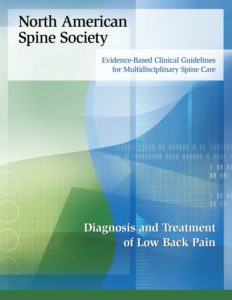
The North American Spine Society (NASS) has released a guidance document, Evidence-Based Clinical Guidelines for Multidisciplinary Spine Care: Diagnosis and treatment of low back pain, to assist practitioners who treat adult patients with non-specific low back pain above the knee.
This guideline provides evidence-based recommendations to address key clinical questions surrounding the diagnosis and treatment of adult patients with non-specific low back pain with leg pain above the knee. It is separated into seven different sections covering: diagnosis; imaging; medical and psychological treatment; physical medicine and rehabilitation; interventional treatment; surgical treatment and cost utility.
In a press statement, NASS said that the document does not represent a standard of care, nor is it intended as a fixed treatment protocol. It is based on a systematic review of the evidence and reflects treatment concepts for non-specific low back pain above the knee as found in the highest quality clinical literature available as of February 2016.
Eleven societies provided stakeholder representatives to assist in the development of this document and provided comments to assist in its review. Compared to a typical NASS guideline with 400–600 literature search results and approximately 30 clinical questions, the Diagnosis and treatment of low back pain guideline resulted in over 45,000 literature search results and contains 82 clinical questions with over 100 recommendation statements.
“This is the largest clinical guideline NASS has ever undertaken,” said D Scott Kreiner (Arizona, USA) co-chair of NASS’ Evidence-Based Guideline Development Committee, and NASS Research Council director.
“Hundreds, if not thousands, of cumulative hours were spent by work group volunteers to develop this resource,” Kreiner stated.
Paul Matz, a Wyoming-based neurosurgeon and co-chair of the Evidence-Based Guideline Development Committee said: “It is important to understand the inclusion and exclusion criteria for this guideline in order to correctly interpret the recommendations. This guideline is focused on a subset of low back pain care as opposed to low back pain in its entirety.”
The patient population for the guideline is adults (18 years or older) with low back pain defined as pain of musculoskeletal origin extending from the lowest rib to the gluteal fold that may at times extend as somatic referred pain into the thigh (above the knee). “The guideline clearly describes the scope, patient population, development methodology, and levels of evidence used,” said Matz. A technical report, including the literature search parameters and evidentiary tables developed by the authors, is also available.













